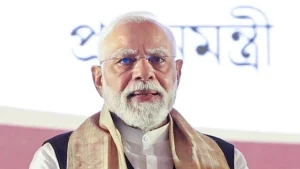New Delhi – The GST 2.0 rollout commenced on Monday, marking a transformative moment in India’s taxation history as Prime Minister Narendra Modi announced that Indians will save ₹2.5 lakh crore through comprehensive tax reforms. In his address to the nation on Sunday evening, Modi characterized this GST 2.0 rollout as a “savings festival” that will benefit citizens across all economic segments.
The GST 2.0 rollout represents the most significant overhaul of India’s consumption tax structure since GST’s original launch in 2017. Modi emphasized that while income tax changes benefit the middle class, the new GST structure will particularly help the poor and neo middle class, creating a comprehensive economic relief package.
Structural Changes in GST 2.0 Rollout

The GST 2.0 rollout fundamentally transforms India’s tax landscape by streamlining the structure from four slabs to essentially two rates of 5% and 18%. This simplification addresses long-standing business concerns about tax complexity while making goods more affordable for consumers.
According to Modi’s explanation of the GST 2.0 rollout, “99% of the goods that earlier attracted 12% GST have now been shifted to 5%,” resulting in significant price reductions for everyday items including medicines, household essentials, and appliances. This restructuring aims to boost consumption during the crucial festive season.
The GST 2.0 rollout timing coincides strategically with Navratri festivities and the peak shopping season, when Indians traditionally increase spending on consumables, clothes, electronics, and home improvements.
Economic Impact and Consumer Benefits
The GST 2.0 rollout is expected to turbocharge consumption across strategically important sectors of the Indian economy. Cheaper automobiles could unlock first-time buyers while encouraging upgrades, stimulating manufacturing and financing ecosystems that employ millions of workers.
Modi highlighted how the GST 2.0 rollout will enable citizens to “save more and buy what they like,” with particular benefits for youth, farmers, women, shopkeepers, traders, and entrepreneurs. The reforms aim to create widespread economic opportunities during the festive season when consumer sentiment typically peaks.
The GST 2.0 rollout includes making insurance tax-free, which expands financial inclusion to previously underserved segments, while cheaper food staples boost discretionary spending precisely when it typically increases during festivals.
MSME Sector Benefits from GST 2.0 Rollout
The GST 2.0 rollout places special emphasis on supporting micro, small, and medium enterprises, which dominate India’s business landscape. Modi explained that reduced GST slabs will allow MSMEs and small traders to increase profits while facing lower tax burdens, creating a “double bonanza” for the sector.
Through the GST 2.0 rollout, the Prime Minister expressed “a lot of expectations” from MSME entrepreneurs, urging them to enhance quality standards to global levels. He emphasized that Indian-made products should “soar past all tests” and achieve “global recognition and pride.”
Also Read: Sam Pitroda Pakistan Shocker: Explosive BJP Attack on Congress Leader
The GST 2.0 rollout’s impact on MSMEs extends beyond immediate tax relief, as enhanced competitiveness could help these businesses expand market share and create additional employment opportunities.
Swadeshi Push Integral to GST 2.0 Rollout
The GST 2.0 rollout incorporates a renewed emphasis on self-reliance and Indian-made goods. Modi declared that “the mantra of swadeshi had given strength to swatantrata (independence); the same mantra will give strength to samridhi (prosperity),” connecting tax reforms to broader economic nationalism.
As part of the GST 2.0 rollout messaging, Modi expressed concern about foreign goods’ prevalence in daily life, noting that Indians often don’t realize whether common items like combs are domestically produced or imported. He called for conscious effort to “get rid of them” and prioritize Indian products.
The GST 2.0 rollout timing supports this swadeshi push by making Indian goods more competitive through reduced taxation, potentially encouraging consumers to choose domestic products over foreign alternatives.
Neo Middle Class and Aspirational India


The GST 2.0 rollout specifically targets what Modi termed the “neo middle class” – 2.5 million people who have “beaten poverty” over the past 11 years. These citizens now play critical roles in India’s economy with distinct aspirations and dreams that the tax reforms aim to fulfill.
Modi emphasized that the GST 2.0 rollout embodies “nagarik devo bhava” (citizen is god) philosophy, making it easier for people to achieve dreams like building homes, purchasing televisions, refrigerators, or vehicles. This approach acknowledges changing consumer aspirations in modern India.
Historical Context and Future Vision
Reflecting on pre-2017 conditions, Modi described how businesses found it easier to ship goods from Bangalore to Hyderabad via Europe due to multiple state taxes and regulations. The GST 2.0 continues reforming this complex legacy system.
The GST 2.0 represents India’s response to external challenges, including US tariffs affecting merchandise exports. By boosting domestic demand through tax relief, India hopes to offset some international trade pressures while strengthening internal economic resilience.
Modi concluded that the GST 2.0 will accelerate India’s growth story while making business easier and investment more attractive, positioning the reforms as fundamental to the nation’s economic transformation and long-term prosperity goals.


